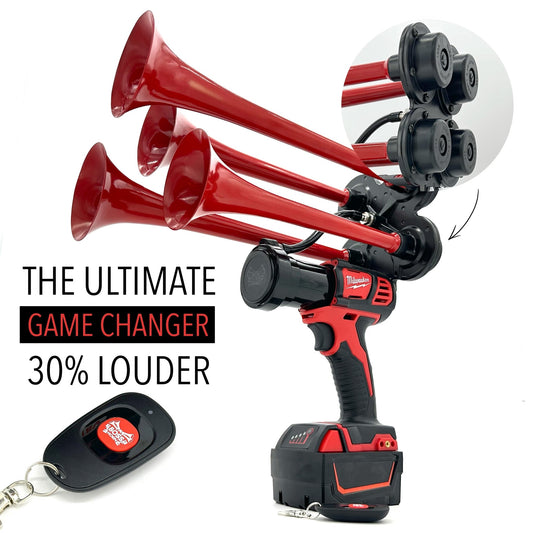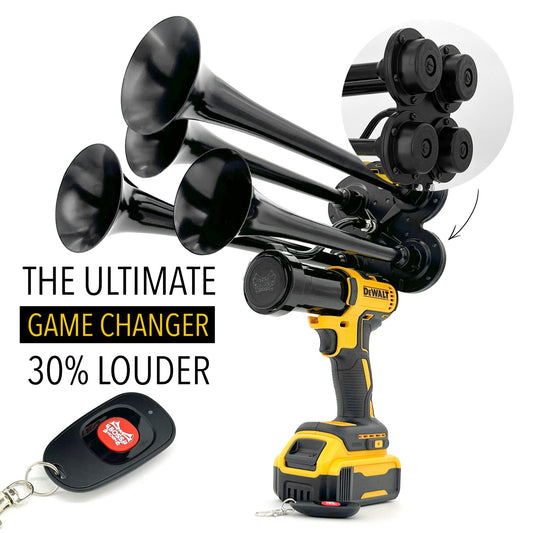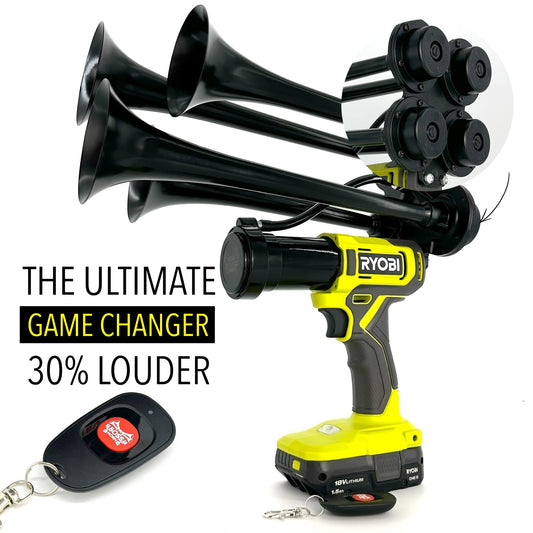Did you know that train horns can produce sound levels of up to 175 decibels, making them one of the loudest warning signals in the world?
The idea of outfitting cars with train horns has been gaining popularity in recent years due to the increased need for louder and more attention-grabbing warning systems on the road. The use of train horns in cars is not a new concept, as some vehicles, especially trucks and SUVs, have been equipped with these powerful horns for quite some time. However, as traffic congestion and distracted driving become more prevalent, many drivers are turning to train horns as a way to alert others of their presence and avoid accidents.
One of the main advantages of using a train horn on your car is the increased safety it provides. With the ability to be heard from a greater distance and through various barriers, such as closed windows or loud music, train horns can help prevent collisions and keep you and your loved ones safe on the road. In fact, studies have shown that the use of louder horns can reduce the likelihood of accidents by up to 50%, making them a valuable addition to any vehicle.
In addition to their safety benefits, train horns also offer a practical solution for drivers who need to communicate with others on the road. Whether you need to alert a distracted driver, signal a pedestrian, or simply get the attention of someone in your way, a train horn can effectively convey your message and help you navigate traffic more efficiently. This versatility makes train horns a valuable tool for everyday driving situations and reinforces their importance in promoting road safety.
How would replacing car horns with train horns impact road safety and noise pollution levels?
Replacing car horns with train horns could potentially increase road safety by providing a louder and more attention-grabbing warning signal for drivers and pedestrians. However, this change may also lead to an increase in noise pollution levels, causing discomfort for residents living near busy roads. To fully explore the implications of this idea, it is essential to consider various factors such as the effectiveness of train horns in different driving environments and the potential regulations needed to mitigate any adverse effects on communities.
Replacing your car's traditional horn with a train horn can be a fun and unique modification for your vehicle. Train horns are much louder and more robust than standard car horns, making them an attention-grabbing addition to any vehicle. However, there are several factors to consider before making this switch.
Potential legal issues:
- Train horns are significantly louder than regular car horns, which could potentially violate noise ordinances in your area.
- Some states have laws specifically prohibiting the use of train horns on vehicles not classified as trains.
Installation process:
- Installing a train horn in place of your car's existing horn may require modifications to the vehicle's electrical system.
- It is essential to ensure that the new horn is securely mounted and does not impede the vehicle's safety features.
Sound considerations:
- Train horns produce a loud, low-frequency sound that carries over long distances. This type of noise can be startling to other drivers and pedestrians.
- It is important to use the horn responsibly and only when necessary to avoid causing unnecessary disturbance or contributing to noise pollution.
Despite these considerations, many car enthusiasts enjoy the novelty and attention that a train horn can bring to their vehicle. If you decide to make the switch, be sure to research and understand the legal implications in your area, invest in a quality horn, and follow proper installation procedures.
According to a study conducted by the National Highway Traffic Safety Administration, excessive noise from car horns is a contributing factor in approximately 6% of all traffic accidents. Additionally, a survey by AAA found that 87% of drivers feel that car horns are overused and misused on the road.
https://youtube.com/watch?v=RLCx2r3S5OU
Can I modify the horn on my vehicle to produce a different sound?
Yes, you can customize the horn on your vehicle to produce a unique sound. However, it is important to consider the legal implications and safety concerns associated with altering the horn.
1. Check local regulations: Before making any modifications to your vehicle's horn, be sure to familiarize yourself with the rules and regulations governing horn usage in your area. It is essential to ensure that the sound produced by your horn meets legal requirements to avoid any potential fines or citations.
2. Consult a professional: It is highly recommended to seek the help of a professional mechanic or automotive expert when making modifications to your vehicle's horn. They can provide guidance on the best practices for altering the horn and ensure that the process is done safely and effectively.
3. Consider safety: When customizing your horn, it is crucial to prioritize safety. Make sure that the new sound produced by the horn is loud enough to be heard by other drivers on the road, but not excessively loud to the point of causing discomfort or distraction. Additionally, be mindful of using the horn in appropriate situations to avoid unnecessary noise pollution.
How can I change the sound of my vehicle's horn?
There are various methods to change the sound of your vehicle's horn, ranging from simple DIY solutions to more complex modifications. Depending on your preferences and technical expertise, you can explore different options to create a unique horn sound.
1. Upgrade the horn: One of the easiest ways to change the sound of your vehicle's horn is to upgrade to a different type of horn. You can choose from a wide range of aftermarket horns that produce different tones and volumes, allowing you to customize the sound to your liking.
2. Install a horn relay: Adding a horn relay to your vehicle can help improve the effectiveness of the horn and enhance the sound quality. A horn relay ensures that the electrical signal to the horn is consistent and stable, resulting in a louder and more reliable sound output.
3. Adjust the horn settings: Some vehicles come equipped with adjustable horn settings that allow you to tweak the tone and volume of the horn. Check your vehicle's manual or consult a professional to see if there are any settings that can be customized to change the sound of the horn.
What are the risks of changing the horn on my vehicle?
While customizing the horn on your vehicle can be a fun and creative process, there are several risks and considerations to keep in mind before making any modifications. It is important to weigh the potential consequences and implications of altering the horn sound.
1. Legal repercussions: Modifying the horn on your vehicle without adhering to local regulations and safety standards can result in legal repercussions. If the sound produced by your horn is deemed too loud or disruptive, you may face fines or citations from authorities.
2. Safety hazards: Changing the horn sound can potentially create safety hazards if the new sound is not loud enough to be heard by other drivers or pedestrians on the road. It is essential to ensure that the modified horn is effective in alerting others to your presence and intentions while driving.
3. Warranty concerns: Modifying the horn on your vehicle may void any existing warranties or coverage from the manufacturer. If you experience any issues or malfunctions with the horn after making modifications, you may not be eligible for repairs or replacements under warranty.
Is it possible to make my vehicle's horn sound like a train horn?
Yes, it is possible to customize your vehicle's horn to produce a sound similar to a train horn. This process involves installing a train horn kit, which is designed to replicate the distinctive sound of a train horn and create a loud and attention-grabbing noise.
1. Train horn kit: To make your vehicle's horn sound like a train horn, you will need to purchase a train horn kit that includes the necessary components for installation. These kits typically consist of a compressor, air tank, and horn assembly that are designed to produce a powerful and resonant sound.
2. Installation process: Installing a train horn kit requires some technical know-how and expertise. It is recommended to consult a professional mechanic or automotive specialist to ensure that the kit is installed correctly and safely. Improper installation can lead to issues with the horn's functionality and performance.
3. Sound customization: Once the train horn kit is installed, you can adjust the sound settings to achieve the desired tone and volume for your vehicle's horn. Most train horn kits come with adjustable settings that allow you to fine-tune the sound output to mimic a train horn effectively.
Conclusion
In conclusion, replacing a car horn with a train horn can provide several benefits such as increased safety on the road due to the louder and more attention-grabbing sound. However, there are also important factors to consider such as legality and regulations regarding vehicle modifications. It is essential to research and understand the implications of making this switch before proceeding with the modification. Ultimately, the decision to replace a car horn with a train horn should be made with careful consideration of all relevant factors to ensure compliance with the law and maintain overall safety on the road.














